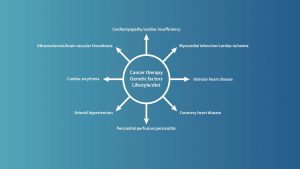Children with cancer who are under the age of 10 are more likely to contract congestive heart failure after receiving cancer therapy.
Developments in cancer therapies have led to overall survival rates exceeding 80% after cancer diagnosed at childhood and early adulthood (YA). Today, there is a growing survivor population at higher risk for morbidity and mortality than the general population.
Premature heart disease after childhood and YA cancer therapy (see Fig. 1) has been recognised as one of the most serious non-malignant complications of cancer treatments. Survivors of childhood cancer also may have earlier development of conventional cardiovascular risk factors such as hypertension, dyslipidemia, and diabetes, which further increase their risk of serious cardiovascular disease.

In a study conducted by Mulrooney et al (2009), the following risk factors for congestive heart failure were identified: aged below 10 years at cancer diagnosis, female gender, cumulative anthracycline exposure >250mg/m2 and the cardiac radiation dose >5 Gy. With respect to myocardial infarction, the only risk factor was radiation >35 Gy, while increasing cardiac radiation doses, cyclophosphamide administration and anthracycline doses >250mg/m2 accounted for the risk factors of pericardial disease.9 The risk of suffering from anthracycline-induced clinical heart failure in childhood cancer survivors has been reported to rise with increasing time after the first anthracycline dose from 2% after two years to 5.5% after 20 years.
A wide range of additional chemotherapeutic drugs such as alkylating agents, antimetabolites, antimicrotubule agents, preoteasome and Tyrosine kinase inhibitors have been reported as further causes for negative cardiovascular effects. Furthermore, other drugs used in chemotherapy such as cytokines (Interleukin-2), all-trans retinoic acid, arsenic trioxide, thalidomide, etoposide and bleomycin have been recognised as risks for cardiac morbidity. Additionally, radiation therapy has shown to predispose to atherosclerosis, vascular stenosis, thromboembolism, transient ischemic attack and strokes. Paediatric cancer treatments including bone marrow transplantation has been identified as a risk factor for the development of metabolic syndrome in addition to the generally known causes, such as physical inactivity and obesity.
Mechanisms for cardiotoxicity are most probably multifactorial and individual sensitivity may vary. Although the precise pathomechanisms leading to acute heart failure and cardiotoxicity remain yet to be revealed, various hypotheses have been proposed including lipid peroxidation, excess oxidative stress, reduced levels of antioxidant and sulphhydryl groups, and the increased release of reactive oxygen species. Separately, the wide range of inter-individual susceptibility to anthracycline-related cardiac failure has led to the hypothesis that genetic variation may contribute to individual susceptibility. To date, genetic variation in more than 20 candidate genes have been described.
A look at home-based physical activity interventions
The focus of research has shifted from optimising cancer therapies for a cure, to managing and possibly preventing late effects after childhood cancer. In addition to cancer therapy, modifiable cardiovascular risk factors after childhood cancer have been shown to add on to the excess risk for premature death and cardiovascular conditions. Current surveillance guidelines are based on the recommendations of the International Late Effects of Childhood Cancer Guideline Harmonization Group. There is new, recently published evidence for the need of changing dose equivalence ratios when comparing other anthracyclines and mitoxantrone to doxorubicin.
Primary prevention strategies include the evolution of oncology treatment protocols to reduce the exposure to anthracyclines, radiation, and other agents known to be cardiotoxic, as well as the development of effective cardioprotective strategies. Secondary prevention strategies are directed towards survivors who have already been exposed to cardiotoxic agents but in whom clinical changes and symptoms have not yet occurred. In our own study, we were able to show positive outcome with a 12-week home-based physical activity intervention in long-term survivors of childhood leukaemia.
As cancer therapy evolves with the adoption of new agents and technology, it remains a challenge to conduct a long-term follow-up of survivors given the long average latency between cancer treatment and cardiotoxicity development. However, leading a healthy lifestyle and regular physical activity are important to reduce and possibly prevent the occurrence of late cardiovascular complications.
Päivi Lähteenmäki
MD, PhD, Senior Consultant in Paediatric Haematology/Oncology
Department of Paediatrics and Adolescent Medicine, Turku University Hospital and Turku University
+35823130670
paivi.maria.lahteenmaki@tyks.fi
https://www.utu.fi/en
References
1 Gatta, G.L., Botta, S., and Rossi, T. et al.2014. Childhood cancer survival in Europe 1999-2007: results of EUROCARE-5- a population-based study. Lancet Oncol, 2014;15: 35-47
2 Madanat-Harjuoja, L.M., and Pokhrel, A. et al. 2014. Childhood cancer survival in Finland (1953-2010): a nation-wide population-based study. Int J Cancer. 2014;135:2129-34
3 Trama, A., and Botta, L. et al. 2016. EUROCARE-5 Working Group. Survival of European adolescents and young adults diagnosed with cancer in 2000-07: population-based data from EUROCARE-5. Lancet Oncol. 2016;17:896-906
4 Oeffinger, K.C., and Mertens, A.C. et al. 2016. Childhood Cancer Survivor Study. Chronic health conditions in adult survivors of childhood cancer. N Engl J Med. 2006;355:1572-82
5 Armstrong, G.T., and Chen, Y. et al. 2016. Reduction in Late Mortality among 5-Year Survivors of Childhood Cancer. N Engl J Med. 2016;374:833-42
6 Chow, E.J., and Leger, K.J. et al. 2019. Paediatric cardio-oncology: epidemiology, screening, prevention, and treatment. Cardiovasc Res. 2019;115:922-934
7 Kremer, L.C., and van Dalen, E.C. et al. 2001. Anthracycline-induced clinical heart failure in a cohort of 607 children: long-term follow-up study. J Clin Oncol. 2001;19:191-6
8 Mertens, A.C., and Liu, Q. et al. 2008. Cause-specific late mortality among 5-year survivors of childhood cancer: the Childhood Cancer Survivor Study. J Natl Cancer Inst. 2008;100:1368-79
9 Mulrooney ,D.A., and Yeazel, M.W. et al. 2009. Cardiac outcomes in a cohort of adult survivors of childhood and adolescent cancer: retrospective analysis of the Childhood Cancer Survivor Study cohort. BMJ. 2009;339:b4606
10 Lipshultz, S.E., and Adams, M.J. et al. 2013. Long-term cardiovascular toxicity in children, adolescents, and young adults who receive cancer therapy: pathophysiology, course, monitoring, management, prevention, and research directions: a scientific statement from the American Heart Association. Circulation. 2013;128:1927-95
11 Prasad, P.K., and Signorello, L.B. et al. 2012. Long-term non-cancer mortality in pediatric and young adult cancer survivors in Finland. Pediatr Blood Cancer. 2012;58:421-7
12 van der Pal, H.J., and van Dalen, E.C. et al. 2012. High risk of symptomatic cardiac events in childhood cancer survivors. J Clin Oncol. 2012;30:1429-37
13 Kero, A.E., and Järvelä, L.S. et al. 2014. Cardiovascular morbidity in long-term survivors of early-onset cancer: a population-based study. Int J Cancer. 2014;134:664-73
14 van Waas, M., and Neggers, S.J. et al. 2010. Components of the metabolic syndrome in 500 adult long-term survivors of childhood cancer. Ann Oncol. 2010;21:1121-6
15 Steinberger, J., and Sinaiko, A.R. et al. 2012. Cardiovascular risk and insulin resistance in childhood cancer survivors. J Pediatr. 2012;160:494-9
16 Armstrong, G.T., and Oeffinger, K.C. et al. 2013. Modifiable risk factors and major cardiac events among adult survivors of childhood cancer. J Clin Oncol. 2013;31:3673-80
17 Kero, A.E. 2016. Late mortality and cardiovascular morbidity after cancer at a young age in Finland. Turun yliopiston julkaisuja – Annales Universitatis Turkuensis Ser. D (1263); Medica – Odontologica. Turku 2016
18 Yeh, E.T., and Bickford, C.L. 2009. Cardiovascular complications of cancer therapy: incidence, pathogenesis, diagnosis, and management. J Am Coll Cardiol. 2009;53:2231-47
19 Senkus, E., and Jassem, J. 2011. Cardiovascular effects of systemic cancer treatment. Cancer Treat Rev. 2011;37:300-11
20 Adams, M.J., and Lipshultz, S.E. 2005. Pathophysiology of anthracycline- and radiation-associated cardiomyopathies: implications for screening and prevention. Pediatr Blood Cancer. 2005;44:600-6
21 Bowers, D.C., and Liu, Y. et al. 2006. Late-occurring stroke among long-term survivors of childhood leukemia and brain tumors: a report from the Childhood Cancer Survivor Study. J Clin Oncol. 2006;24:5277-82
22 Taskinen, M., and Saarinen-Pihkala, U.M. et al. 2000. Impaired glucose tolerance and dyslipidaemia as late effects after bone-marrow transplantation in childhood. Lancet. 2000;356:993-7
23 Smith, W.A., and Li, C. et al. 2014. Lifestyle and metabolic syndrome in adult survivors of childhood cancer: a report from the St. Jude Lifetime Cohort Study. Cancer. 2014;120:2742-50
24 Wilhelmsson, M., and Glosli, H. et al. 2019. Nordic Society of Pediatric Hematology and Oncology (NOPHO). Long-term health outcomes in survivors of childhood AML treated with allogeneic HSCT: a NOPHO-AML Study. Bone Marrow Transplant. 2019;54:726-736
25 Minotti, G., and Menna, P. et al. 2004. Anthracyclines: molecular advances and pharmacologic developments in antitumor activity and cardiotoxicity. Pharmacological reviews. 2004;56:185-229
26 Henriksen, P.A. 2018. Anthracycline cardiotoxicity: an update on mechanisms, monitoring and prevention. Heart. 2018;104:971-977
27 Chow, E.J, and Chen, Y. et al. 2018. Prediction of Ischemic Heart Disease and Stroke in Survivors of Childhood Cancer. J Clin Oncol. 2018;36:44-52
28 Armenian, S.H., and Hudson, M.M. et al. 2015. Recommendations for cardiomyopathy surveillance for survivors of childhood cancer: a report from the International Late Effects of Childhood Cancer Guideline Harmonization Group. Lancet Oncol 2015;16:e123–e136
29 Feijen, E.A.M., and Leisenring, W.M. et al. 2019. Derivation of Anthracycline and Anthraquinone Equivalence Ratios to Doxorubicin for Late-Onset Cardiotoxicity. JAMA Oncol. 2019;5:864-871
30 Järvelä, L.S., and Kemppainen, J. et al. 2012. Effects of a home-based exercise program on metabolic risk factors and fitness in long-term survivors of childhood acute lymphoblastic leukemia. Pediatr Blood Cancer 2012;59:155–160
Please note, this article will feature in the March 2020 issue of our publication.







